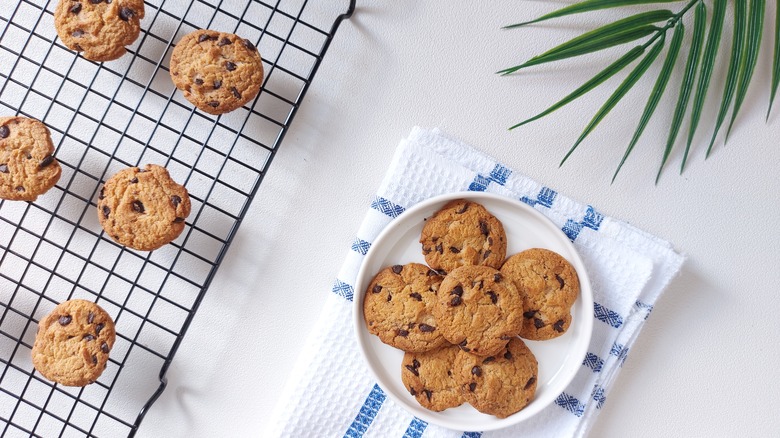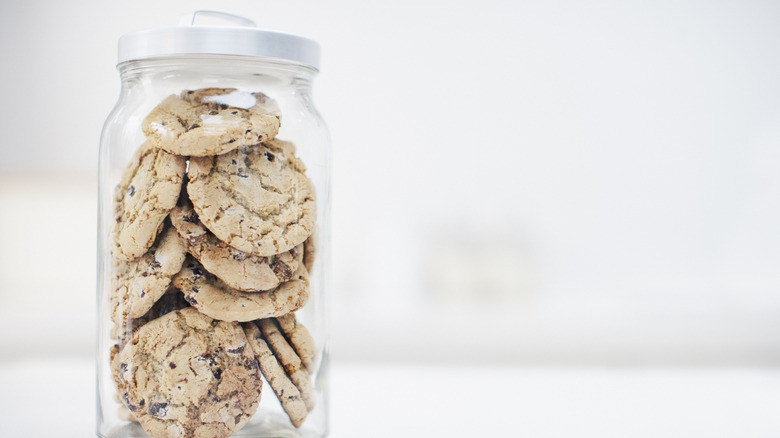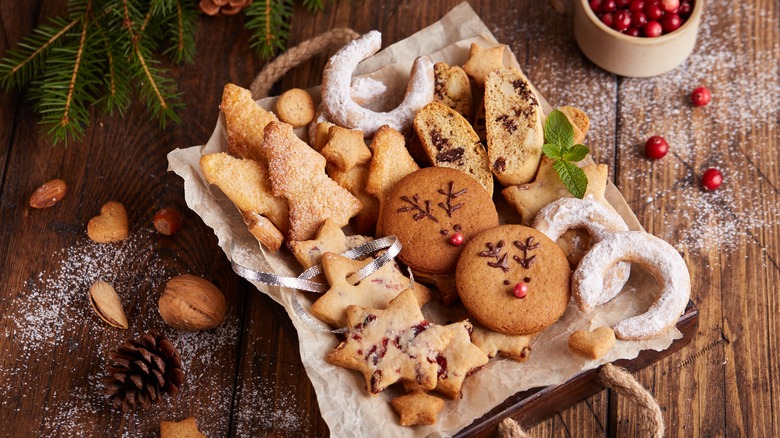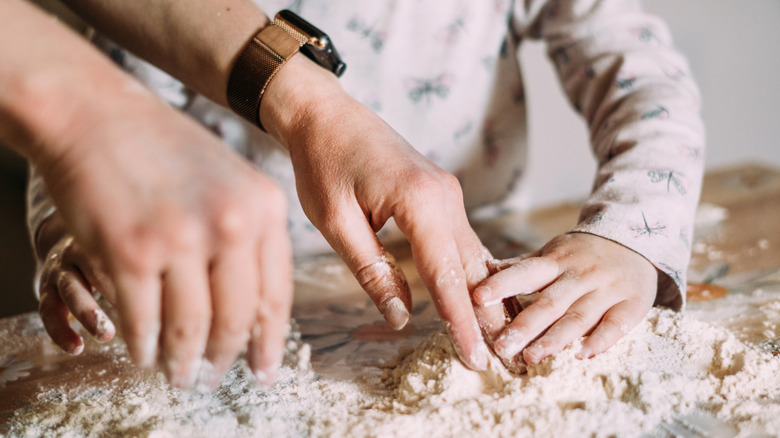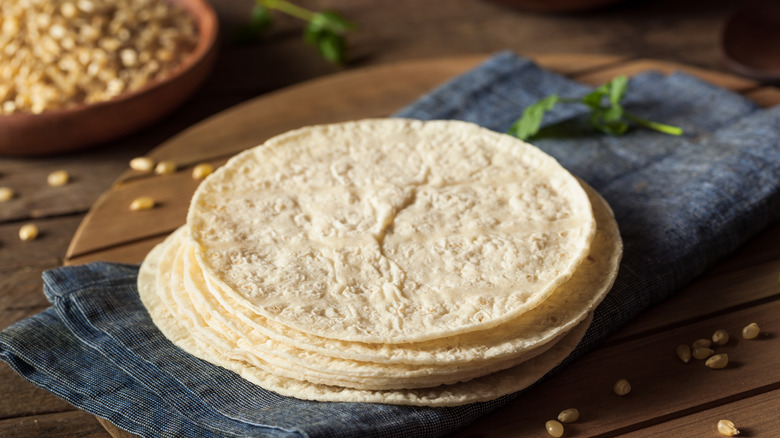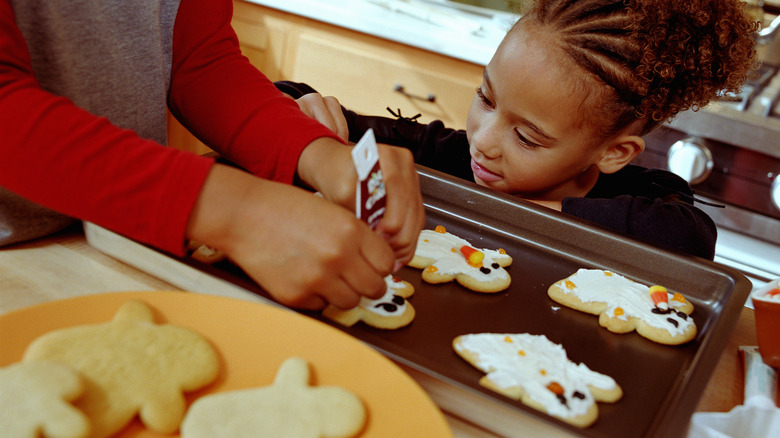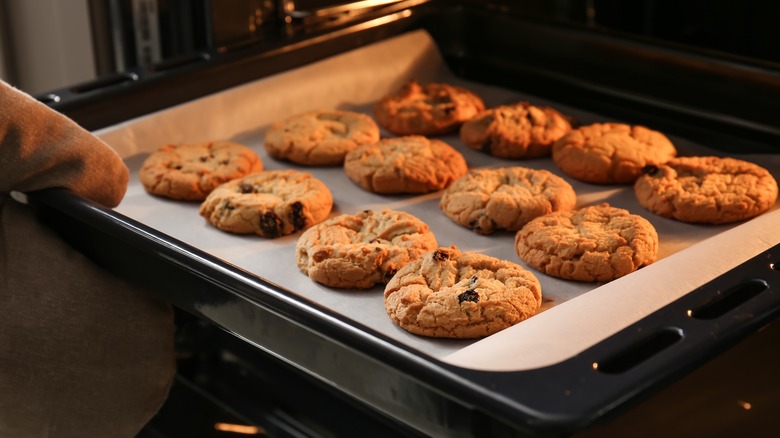How To Keep Christmas Cookies Fresh
There is nothing quite like biting into a warm, fresh cookie minutes after it comes out of the oven. When the holidays roll around, it's practically required to crank up the oven and whip up a batch of cookies to give to a loved one (or enjoy by yourself). Unfortunately, this time of year can get hectic fast, between preparing and attending holiday feasts, buying and wrapping presents, and decorating the tree. Our advice? Get a jump on holiday baking by making the cookies ahead of time.
Depending on the recipe and method of storage, Christmas cookies can be made a few weeks to months in advance. Even after storage, proper handling can make a cookie taste as fresh as the day it was baked. Whether you plan to make them yourself or mail order them as gifts, we've rounded up our best advice for storing cookies to ensure maximum freshness by the time they reach your mouth.
Let them cool
A hot, fresh cookie is truly a thing of beauty. People go to great lengths to get their hands on warm cookies without the hassle of making them from scratch. Even though warm cookies are better for eating if you plan to store the cookies for any amount of time, the best practice is to wait until they are completely cooled. Warm cookies let off heat and steam, which can make them soggy if trapped within a container. A solid 10 to 15 minutes of cooling time should be sufficient for most cookie recipes.
Once the cookies are cooled, the next step might be frosting — depending on the recipe. If you're working with buttercream, another round of sitting on the counter before transferring it to a container will benefit the freshness of the cookie. Buttercream develops a hard, sugar coating when exposed to air (even though the frosting underneath stays soft) that does much better in storage.
Store them right
The enemy of a fresh cookie is exposure to air. Humid environments can make cookies soggy and stale, while dry environments lead to tough, crumbly cookies with no chewy texture. The best way to avoid these environmental challenges is to keep the cookies in an airtight container. According to Keturah Fleming-Hall, owner and head baker of La Fillette Bakery in Denver, Colorado, "Keeping them tightly wrapped is your best bet." If you happen to have a cookie jar, that could be a good option. Otherwise, a Ziploc bag or plastic (or glass) Tupperware can do the job just as easily. Avoid loosely wrapping with foil or parchment paper — there is too much airflow for the cookies to stay at optimum freshness.
At room temperature, most cookies will stay fresh if tightly sealed for up to five days. If you need to store your baked cookies for a bit longer than that, they should last up to 10 days in the refrigerator. Ideally, each layer of cookies should be stored between layers of parchment or wax paper to avoid sticking together.
Keep them separated
The classic Christmas cookie is a plain sugar cookie, sometimes frosted with buttercream or royal icing and dusted with sprinkles. However, any true cookie connoisseur knows that there is a whole world of holiday cookies. From gingersnap to pfeffernüsse to rugelach, the range of Christmas cookie types is vast. Knowing what kind of cookie you are trying to store will help immensely when trying to keep them fresh. Different kinds of cookies have different compositions in terms of ingredients, which is why you should always separate cookies by type before storing them.
Cookies with a more moist texture can cause crispier cookies to get soggy, and cookies with certain flavors or coatings (like the powdered sugar on classic snowball cookies) have a tendency to spread to anything else they are stored with. If your plan is to gift or ship a cookie tin, use parchment paper or muffin liners to separate cookies by type.
Utilize the freezer
The freezer is a great way to preserve foods of all kinds, including Christmas cookies. Frozen, baked cookies can last for months in the freezer if packaged tightly and stored properly. A solid, airtight container is a must, as well as pieces of parchment or wax paper between layers. Make sure to label and date anything you put in the freezer (even if you only plan to store them there for a few days) to avoid confusion down the line. The last thing you want is to unearth a batch of forgotten cookies in May!
Baked cookies can be defrosted at room temperature for 10 to 20 minutes. For sugar cookies, you don't necessarily have to wait until they are completely thawed to start decorating. The cookie will continue to defrost while you work, and the icing will set quickly on a cold cookie. If you want a warm cookie from the freezer, just pop them in the oven at 350 F for a few minutes.
You can freeze the dough, too
The freezer isn't just for baked cookies. "We like to roll out shortbread cookie shapes and keep them in the freezer till we are ready to bake and decorate them," says Fleming-Hall. Sugar cookie or gingerbread dough can be rolled out and frozen as early as three months ahead. Start by rolling your just-made dough between two sheets of parchment paper to the desired thickness. The frozen sheets stack well and can fit easily in the freezer. When you are ready to bake, simply stamp out shapes and bake from frozen. Sugar cookies bake with much cleaner edges when frozen solid right before baking.
The same principles can be applied to chocolate chip cookies. You can make the dough and scoop them using a cookie scoop into balls, then freeze the balls. The frozen balls can be baked from frozen by simply adding four to five minutes to the overall bake time. Some cookies with high sugar content (think tuiles, pizzelles, or florentines) don't work well in the freezer whether baked or raw.
Use tortillas
One of the best hacks for keeping Christmas cookies fresh may just be storing them with a tortilla. Plain tortillas don't have a strong smell or flavor, and their thin, circular shape fits perfectly in between layers in a cookie tin. Don't have any tortillas? A slice of bread could work well also (it does wonders when trying to keep brown sugar from hardening). The mechanics are the same: The tortilla or slice of bread absorbs moisture so that it doesn't end up turning the cookies or candy stale.
For a gluten-free option, food-safe silica packets are the item used by professional food stylists and commercial bakeries. These packets work in much the same way by absorbing moisture from the air in the container so it doesn't end up soaking into the cookies. They can be a little pricier than tortillas or slices of bread, but they can be reused infinitely and have no flavor or odor whatsoever.
Don't ice too early
Once all the baking is done, the real fun begins. Frosting, decorating, and the icing is the best part of making Christmas cookies, and this is the time when you can really flex your creative skills. The excitement of decorating might make you anxious to get started as early as possible, but before you do, consider waiting.
Depending on the kind of icing you plan on using, ultimate cookie freshness can really only be achieved by waiting to ice the cookie until right before eating. Of course, this requires a certain finesse in terms of time management, but if you can, the best practice is to ice your cookies at the last possible moment. The moisture in the icing can seep into the cookie and can turn deliciously crisp edges into a mushy mess in a matter of minutes. Don't have time to wait? Try using a drier royal icing over a soft buttercream.
Don't bake them too long
Though it might go against what you might think, baking cookies too long can shorten the shelf life. "When baking most cookies, underbaking them will keep them moist longer and better tasting," says Fleming-Hall. The trick here is finding the sweet spot between "slightly underbaked" and "still raw inside."
Many factors go into how long a cookie needs to bake, from the model of the oven they are being baked in, to the humidity of the environment that day, which is why following the exact recipe time might be a bad idea. Typically, cookies can be assessed visually for doneness. The edges should be firm to a light touch and just starting to brown, while the middle should be soft but not wet or raw-looking. Remember that cookies will continue to bake slightly on the hot sheet tray while they are cooling, so taking them out when they look done will lead to over-baked and possibly burnt cookies.
Store soft and hard cookies separately
There are several different types of Christmas cookies, and the hard part comes with deciding which to store where. First off, you have your soft cookies — like your chocolate chip, plush peanut butter blossoms, and the like. Then there are your hard cookies like gingerbread and snappy molasses cookies. It's important to store these cookies in separate, airtight containers because the soft cookies will add moisture to the hard cookies, making them squishy, while the hard cookies will pull moisture from the soft cookies and make them crunchy.
This might involve some extra work — mainly taking your cookies from your paper gift box and into separate containers that lockout or keep in the moisture, but it will preserve the quality of your cookies for days to come. After all, nobody wants to eat a limp gingerbread man or break a tooth on a soft Mexican sugar cookie.

